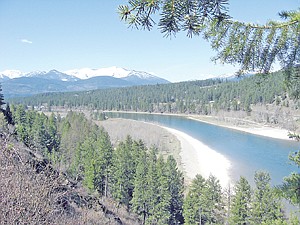A River Threatened
The Kootenai River, the lifeblood of Libby, has been named one of the nation’s 10 Most Endangered Rivers, primarily because of pollution from coal mining in southeastern British Columbia.
The designation was announced Wednesday by the American Rivers conservation organization.
The coal mines are in the Elk River drainage, which feeds into the Kootenay River in Canada and then into Lake Koocanusa that straddles the U.S.-Canadian border.
Beyond Libby Dam, the Kootenai River flows through Western Montana and into Idaho.
It is the second largest tributary to the Columbia River Basin by volume, draining an 18,000-square-mile watershed.
Last month, the University of Montana released research confirming that runoff from the mines has raised selenium levels in the Elk River to more than 10 times natural “background” levels.
Selenium is an element that becomes toxic to fish and wildlife at unnaturally high levels. The Kootenai Basin is home to threatened bull trout and the endangered white sturgeon, and it is an important water source for rivers that support protected salmon species in the Columbia Basin.
“Our America’s Most Endangered Rivers report is a call to action to save rivers that face a critical decision point in the next year,” said Scott Bosse, the organization’s Northern Rockies regional director. “The Kootenai is one of the most spectacular rivers in this part of the country, but it faces an uncertain future due to open-pit coal mining across the border in British Columbia. We hope this listing inspires citizens and elected leaders on both sides of the border to take swift and decisive action.”
This week, the British Columbia Globe and Mail reported that the provincial government has issued a ministerial order to Teck Coal Ltd., the company operating five Elk River coal mines, to submit a plan for dealing with the high levels of selenium and other contaminants in the watershed. The order applies not only to the Elk River but to Lake Koocanusa.
“The province takes the issue of selenium and other contaminants in our water very seriously and ... is taking action to invoke immediate change in the region’s water quality trends,” B.C. Environment Minister Terry Lake said.
A Teck Coal spokeswoman said the company already has started to address the matter.
“We know we have an issue, and we are working hard to try and help resolve that issue,” she said, adding that the company expects to spend $600 million during the next five years on environmental projects.
Although the source of pollution is in Canada, it is having an impact in Montana, said Michael Jamison, Glacier program manager for the National Parks Conservation Association.
“The waters of the Kootenay River flow constantly across the border from British Columbia to Montana, and unfortunately so do the mine pollutants,” Jamison said. “What’s needed today is a moratorium on Canadian mine expansion until we can gather baseline data and establish a long-term mitigation plan. As downstream residents, we obviously have a very keen interest in what our upstream neighbors are sending our way.”
In Libby, Dave Blackburn, the owner and lead guide of the Kootenai Angler, said the river has been struggling for years.
“The river has been listed for other reasons in the past,” Blackburn said. “It seems like we never get a rest.”
American Rivers also designated as endangered the Colorado River, the Flint River in Georgia; the San Baba River in Texas; the Little Plover River in Wisconsin; the Catawba River in the Carolinas; the Boundary Waters Canoe Area Wilderness in Minnesota; the Black Warrior River in Alabama; the Rough and Ready Baldface creeks in Oregon; the Niobrara River in Nebraska, South Dakota and Wyoming; and the Merced River in California.
(The Western News staff contributed to this report.)


